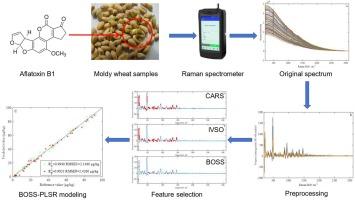Determination of aflatoxin B1 in wheat using Raman spectroscopy combined with chemometrics
IF 4.3
2区 化学
Q1 SPECTROSCOPY
Spectrochimica Acta Part A: Molecular and Biomolecular Spectroscopy
Pub Date : 2024-11-03
DOI:10.1016/j.saa.2024.125384
引用次数: 0
Abstract
Aflatoxin B1 (AFB1) is carcinogenic and highly susceptible to production in wheat. In this study, the quantitative detection of contaminant AFB1 in wheat was investigated by Raman spectroscopy combined with chemometric method realization. Firstly, Savitzky–Golay smoothing (SG) and baseline calibration methods were used to perform the necessary preprocessing of the collected raw Raman spectra. Then, three variable optimization methods, i.e., competitive adaptive reweighted sampling (CARS), iteratively variable subset optimization (IVSO), and bootstrap soft shrinkage (BOSS), were applied to the preprocessed wheat Raman spectra. Finally, partial least squares regression (PLSR) models were developed to determine AFB1 in wheat samples. The results showed that all three variable optimization algorithms significantly improved the predictive performance of the models. The BOSS-PLSR model has strong generalization performance and robustness. Its prediction coefficient of determination () was 0.9927, the root mean square error of prediction (RMSEP) was 2.4260 /kg, and the relative prediction deviation (RPD) was 11.5250, respectively. In conclusion, the combination of Raman spectroscopy and chemometrics can realize the rapid quantitative detection of AFB1 in wheat.

利用拉曼光谱结合化学计量学测定小麦中的黄曲霉毒素 B1。
黄曲霉毒素 B1(AFB1)是一种致癌物质,极易在小麦中产生。本研究采用拉曼光谱结合化学计量学方法实现了对小麦中污染物 AFB1 的定量检测。首先,采用萨维茨基-戈莱平滑法(SG)和基线校准法对采集到的原始拉曼光谱进行必要的预处理。然后,对预处理后的小麦拉曼光谱应用三种变量优化方法,即竞争性自适应加权采样(CARS)、迭代变量子集优化(IVSO)和引导软收缩(BOSS)。最后,建立了偏最小二乘回归(PLSR)模型来测定小麦样品中的 AFB1。结果表明,这三种变量优化算法都显著提高了模型的预测性能。BOSS-PLSR 模型具有很强的泛化性能和稳健性。其预测决定系数(RP2)为 0.9927,预测均方根误差(RMSEP)为 2.4260 μg/kg,相对预测偏差(RPD)为 11.5250。综上所述,拉曼光谱与化学计量学相结合可实现小麦中 AFB1 的快速定量检测。
本文章由计算机程序翻译,如有差异,请以英文原文为准。
求助全文
约1分钟内获得全文
求助全文
来源期刊
CiteScore
8.40
自引率
11.40%
发文量
1364
审稿时长
40 days
期刊介绍:
Spectrochimica Acta, Part A: Molecular and Biomolecular Spectroscopy (SAA) is an interdisciplinary journal which spans from basic to applied aspects of optical spectroscopy in chemistry, medicine, biology, and materials science.
The journal publishes original scientific papers that feature high-quality spectroscopic data and analysis. From the broad range of optical spectroscopies, the emphasis is on electronic, vibrational or rotational spectra of molecules, rather than on spectroscopy based on magnetic moments.
Criteria for publication in SAA are novelty, uniqueness, and outstanding quality. Routine applications of spectroscopic techniques and computational methods are not appropriate.
Topics of particular interest of Spectrochimica Acta Part A include, but are not limited to:
Spectroscopy and dynamics of bioanalytical, biomedical, environmental, and atmospheric sciences,
Novel experimental techniques or instrumentation for molecular spectroscopy,
Novel theoretical and computational methods,
Novel applications in photochemistry and photobiology,
Novel interpretational approaches as well as advances in data analysis based on electronic or vibrational spectroscopy.

 求助内容:
求助内容: 应助结果提醒方式:
应助结果提醒方式:


